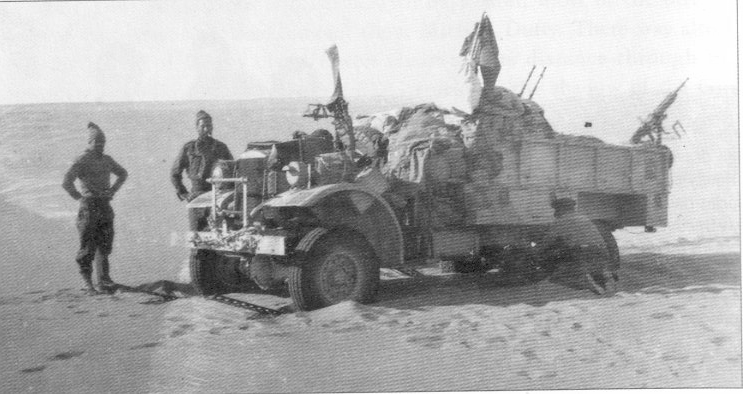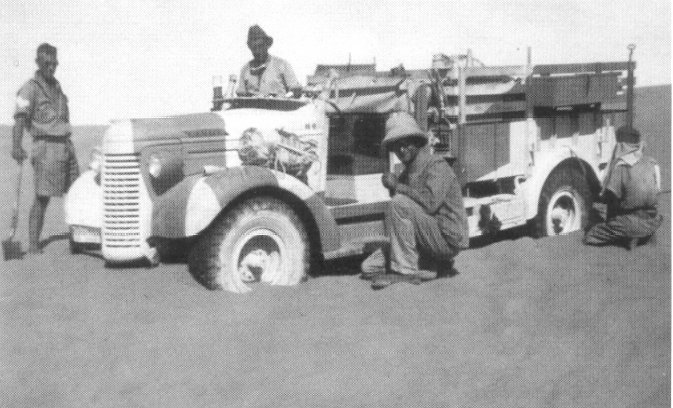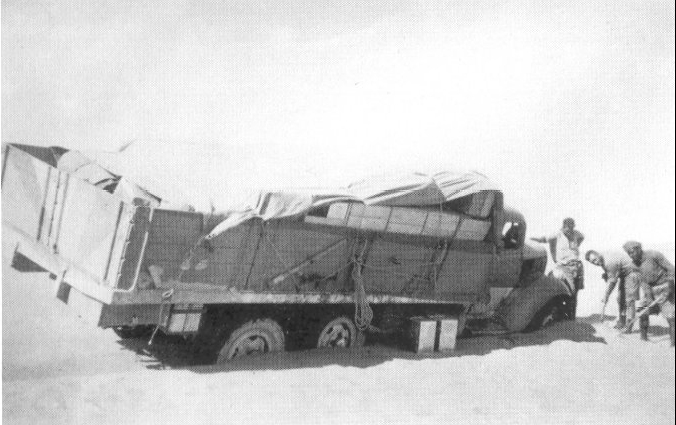These questions and their core concepts were stress-tested in the North African desert by folks who should know.
We see up first, the Ford contender. She's also the 4X4 and the purpose-built unit.
May I present: the Ford F30 CMP. This stout looker had four-wheel-drive and was powered by the venerable 239 CID flathead V8.
It was built to the standard known as "Canadian Military Pattern" ("CMP" in the nomenclature) which is why it looks the way it does. Cab-over to save space aboard ship and a forward-sloping windshield intended to reduce glare and reflection.
Our quasi-focus-group tested the Ford and the Chevy below.
This Chevy missed the memo about attire being "tactical."
Representing the Bowtie side of the fight is the Chevrolet 15533X2, ton-and-a-half truck.
Accuracy point: the truck pictured looks to have the 157" wheelbase instead of the 134" of the trucks we'll be discussing.
Okay, her engine spins out less horsepower than the Ford's but - it's an absolutely bombproof, straight-six; God's most perfect engine. 235 CID in this case, same as the one that powered the '63 Biscayne wagon I rode in as a lad.
Now, on to the venue:
I think I already said, North Africa.
In a vain hope of putting everything in some sort of context, here's the machine that our two contenders showed up to relieve:
It was called the Chevy WB and was essentially the same rig as the one above - just a model year or so earlier. An off-the-rack, 1940 Chevy, 30 CWT, fresh off the showroom floor in Cairo.
Nowadays, the only survivor of this first generation of trucks used (Read: Ran into the ground) by the LRDG is one of these stone-age relics, now in the Imperial war Museum.
That's "Long-Range-Desert-Group." I prattled about them a bit here.
Follow the LRDG link - and this one for more.
in short, this was a largely-Kiwi, reconnaissance and sabotage unit that operated far behind German lines in Egypt and Tunisia.
In addition to just driving around in the desert fucking with the Germans, blowing up airfields, attacking convoys and being general nuisances, the LRDG transported and supplied the SAS.
The Special Air Service were the guys with the coolest Jeeps that can ever possibly exist, have existed or ever be allowed to exist again.
These vehicles from my childhood were the shit below the shit!
As a young lad I recall carefully arranging my schedule (such as it was) around this gripping drama: back in the day, I saw it in black and white and never noticed how incredibly un-filthy these guys are - and the red kepi! Whiskey Tango Foxtrot!
But I digress, back to the trucks these two flavors of Detroit iron (Canadian-built in both cases but... ) were both of ton-and-a-half capacity - or 30 CWT (thirty hundred-weight) as the Commonwealth put it.
The bowtie and blue oval were both tasked to pull the same duty, mostly driving around in the desert looking for bad guys. Trips of six-hundred miles occasionally.
And both worked a treat.
Neither of them look quite the same without their makeup do they? Makeup being: Doors, hoods, grill-bars. bumpers, windshields...
That's how they rolled.
Every six pounds of extraneous metal that could be disposed of meant an extra gallon of gas that could be carried
Time for some action shots - with occasional narration.
So who won? They were identical in wheelbase length, similar engines and aside from fwd there's not a lot of difference except - handy and un-stickable as the Ford was, it ate way too much gas.
If a patrol was going to cover 600 miles (something that was not uncommon) The Ford would need 100 gallons of petrol. Normal fuel capacity was by two 12 ½ gallon tanks. This meant the additional 75 gallons would be carried in 15 jerry cans, adding 450 pounds to the payload. Besides the weight, 15 jerry cans would also take up valuable space.
The Chevrolet, on the other hand, managed about 12 MPG. The standard gas tank held 20 gallons. At twelve miles to the gallon, the Chevrolet would need only 50 gallons for the same 600 mile patrol. This means the Chevrolet would need to carry only an additional 30 gallons or 6 cans of petrol. The 30 gallons of petrol would only increase the payload by 180 pounds instead of 450 pounds.
Couldn't have said it better. It's not like the Ford F30 CMP was junk by any means. The top photo shows one outfitted as an ARTY tractor. They were the shit and used for all kinds of tasks elsewhere. They just didn't work out for a truck going a long way, having to carry its own gas.
The Fords were kept around and used as needed but the Chevy's carried the freight.
And they got stuck - a lot.

Happens in the best of families. In this case to an LRDG, "heavy section" six-ton Marmon-Herrington 6X6.
As a wise man once said (Okay. It was me. A wise ass; for sure but otherwise... And... once? I say it all the time.)
"Ya ain't struck 'till ya gotta walk."
That is: walk other than: back up to the cab to... get another beer and think this over.












Another good one!
ReplyDeleteMight want to check out "Sea of Sand" oldie but goodie)
And Killing Rommel by Pressfield, he's quite the Motörhead
Keep bringing the good stuff,
b0i76j6w84 t7r36h7e91 b7s43e0j45 z5g15p5u06 j2r97l8w26 w1v95v1r58
ReplyDeleteCars are interesting.
ReplyDelete